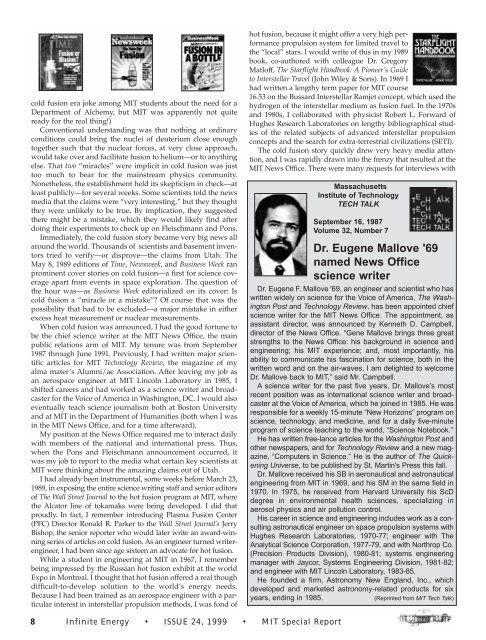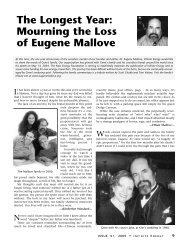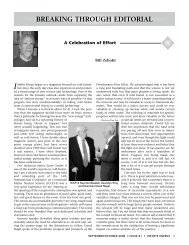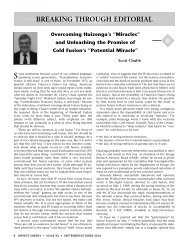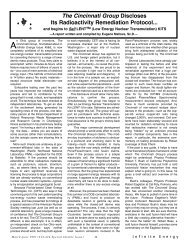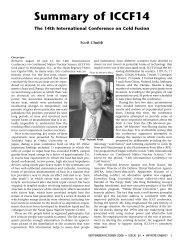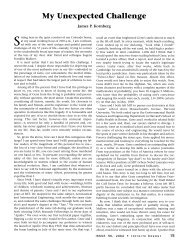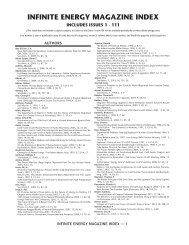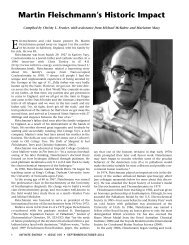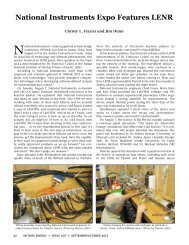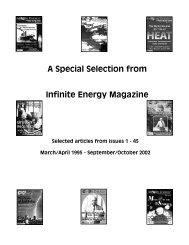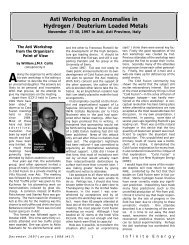MIT and Cold Fusion: A Special Report - Infinite Energy Magazine
MIT and Cold Fusion: A Special Report - Infinite Energy Magazine
MIT and Cold Fusion: A Special Report - Infinite Energy Magazine
Create successful ePaper yourself
Turn your PDF publications into a flip-book with our unique Google optimized e-Paper software.
cold fusion era joke among <strong>MIT</strong> students about the need for a<br />
Department of Alchemy, but <strong>MIT</strong> was apparently not quite<br />
ready for the real thing!)<br />
Conventional underst<strong>and</strong>ing was that nothing at ordinary<br />
conditions could bring the nuclei of deuterium close enough<br />
together such that the nuclear forces, at very close approach,<br />
would take over <strong>and</strong> facilitate fusion to helium—or to anything<br />
else. That two “miracles” were implicit in cold fusion was just<br />
too much to bear for the mainstream physics community.<br />
Nonetheless, the establishment held its skepticism in check—at<br />
least publicly—for several weeks. Some scientists told the news<br />
media that the claims were “very interesting,” but they thought<br />
they were unlikely to be true. By implication, they suggested<br />
there might be a mistake, which they would likely find after<br />
doing their experiments to check up on Fleischmann <strong>and</strong> Pons.<br />
Immediately, the cold fusion story became very big news all<br />
around the world. Thous<strong>and</strong>s of scientists <strong>and</strong> basement inventors<br />
tried to verify—or disprove—the claims from Utah. The<br />
May 8, 1989 editions of Time, Newsweek, <strong>and</strong> Business Week ran<br />
prominent cover stories on cold fusion—a first for science coverage<br />
apart from events in space exploration. The question of<br />
the hour was—as Business Week editorialized on its cover: Is<br />
cold fusion a “miracle or a mistake”? Of course that was the<br />
possibility that had to be excluded—a major mistake in either<br />
excess heat measurement or nuclear measurements.<br />
When cold fusion was announced, I had the good fortune to<br />
be the chief science writer at the <strong>MIT</strong> News Office, the main<br />
public relations arm of <strong>MIT</strong>. My tenure was from September<br />
1987 through June 1991. Previously, I had written major scientific<br />
articles for <strong>MIT</strong> Technology Review, the magazine of my<br />
alma mater’s Alumni/ae Association. After leaving my job as<br />
an aerospace engineer at <strong>MIT</strong> Lincoln Laboratory in 1985, I<br />
shifted careers <strong>and</strong> had worked as a science writer <strong>and</strong> broadcaster<br />
for the Voice of America in Washington, DC. I would also<br />
eventually teach science journalism both at Boston University<br />
<strong>and</strong> at <strong>MIT</strong> in the Department of Humanities (both when I was<br />
in the <strong>MIT</strong> News Office, <strong>and</strong> for a time afterward).<br />
My position at the News Office required me to interact daily<br />
with members of the national <strong>and</strong> international press. Thus,<br />
when the Pons <strong>and</strong> Fleischmann announcement occurred, it<br />
was my job to report to the media what certain key scientists at<br />
<strong>MIT</strong> were thinking about the amazing claims out of Utah.<br />
I had already been instrumental, some weeks before March 23,<br />
1989, in exposing the entire science writing staff <strong>and</strong> senior editors<br />
of The Wall Street Journal to the hot fusion program at <strong>MIT</strong>, where<br />
the Alcator line of tokamaks were being developed. I did that<br />
proudly. In fact, I remember introducing Plasma <strong>Fusion</strong> Center<br />
(PFC) Director Ronald R. Parker to the Wall Street Journal’s Jerry<br />
Bishop, the senior reporter who would later write an award-winning<br />
series of articles on cold fusion. As an engineer turned writerengineer,<br />
I had been since age sixteen an advocate for hot fusion.<br />
While a student in engineering at <strong>MIT</strong> in 1967, I remember<br />
being impressed by the Russian hot fusion exhibit at the world<br />
Expo in Montreal. I thought that hot fusion offered a real though<br />
difficult-to-develop solution to the world’s energy needs.<br />
Because I had been trained as an aerospace engineer with a particular<br />
interest in interstellar propulsion methods, I was fond of<br />
hot fusion, because it might offer a very high performance<br />
propulsion system for limited travel to<br />
the “local” stars. I would write of this in my 1989<br />
book, co-authored with colleague Dr. Gregory<br />
Matloff, The Starflight H<strong>and</strong>book: A Pioneer’s Guide<br />
to Interstellar Travel (John Wiley & Sons). In 1969 I<br />
had written a lengthy term paper for <strong>MIT</strong> course<br />
16.53 on the Bussard Interstellar Ramjet concept, which used the<br />
hydrogen of the interstellar medium as fusion fuel. In the 1970s<br />
<strong>and</strong> 1980s, I collaborated with physicist Robert L. Forward of<br />
Hughes Research Laboratories on lengthy bibliographical studies<br />
of the related subjects of advanced interstellar propulsion<br />
concepts <strong>and</strong> the search for extra-terrestrial civilizations (SETI).<br />
The cold fusion story quickly drew very heavy media attention,<br />
<strong>and</strong> I was rapidly drawn into the frenzy that resulted at the<br />
<strong>MIT</strong> News Office. There were many requests for interviews with<br />
Massachusetts<br />
Institute of Technology<br />
TECH TALK<br />
September 16, 1987<br />
Volume 32, Number 7<br />
Dr. Eugene Mallove '69<br />
named News Office<br />
science writer<br />
Dr. Eugene F. Mallove '69, an engineer <strong>and</strong> scientist who has<br />
written widely on science for the Voice of America, The Washington<br />
Post <strong>and</strong> Technology Review, has been appointed chief<br />
science writer for the <strong>MIT</strong> News Office. The appointment, as<br />
assistant director, was announced by Kenneth D. Campbell,<br />
director of the News Office. “Gene Mallove brings three great<br />
strengths to the News Office: his background in science <strong>and</strong><br />
engineering; his <strong>MIT</strong> experience; <strong>and</strong>, most importantly, his<br />
ability to communicate his fascination for science, both in the<br />
written word <strong>and</strong> on the air-waves. I am delighted to welcome<br />
Dr. Mallove back to <strong>MIT</strong>,” said Mr. Campbell.<br />
A science writer for the past five years, Dr. Mallove’s most<br />
recent position was as international science writer <strong>and</strong> broadcaster<br />
at the Voice of America, which he joined in 1985. He was<br />
responsible for a weekly 15-minute “New Horizons” program on<br />
science, technology, <strong>and</strong> medicine, <strong>and</strong> for a daily five-minute<br />
program of science teaching to the world, “Science Notebook.”<br />
He has written free-lance articles for the Washington Post <strong>and</strong><br />
other newspapers, <strong>and</strong> for Technology Review <strong>and</strong> a new magazine,<br />
“Computers in Science.” He is the author of The Quickening<br />
Universe, to be published by St. Martin's Press this fall.<br />
Dr. Mallove received his SB in aeronautical <strong>and</strong> astronautical<br />
engineering from <strong>MIT</strong> in 1969, <strong>and</strong> his SM in the same field in<br />
1970. In 1975, he received from Harvard University his ScD<br />
degree in environmental health sciences, specializing in<br />
aerosol physics <strong>and</strong> air pollution control.<br />
His career in science <strong>and</strong> engineering includes work as a consulting<br />
astronautical engineer on space propulsion systems with<br />
Hughes Research Laboratories, 1970-77; engineer with The<br />
Analytical Science Corporation, 1977-79, <strong>and</strong> with Northrop Co.<br />
(Precision Products Division), 1980-81; systems engineering<br />
manager with Jaycor, Systems Engineering Division, 1981-82;<br />
<strong>and</strong> engineer with <strong>MIT</strong> Lincoln Laboratory, 1983-85.<br />
He founded a firm, Astronomy New Engl<strong>and</strong>, Inc., which<br />
developed <strong>and</strong> marketed astronomy-related products for six<br />
years, ending in 1985.<br />
(Reprinted from <strong>MIT</strong> Tech Talk)<br />
8 <strong>Infinite</strong> <strong>Energy</strong> • ISSUE 24, 1999 • <strong>MIT</strong> <strong>Special</strong> <strong>Report</strong>


